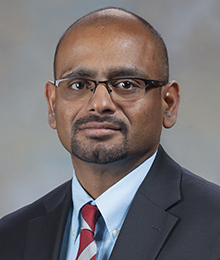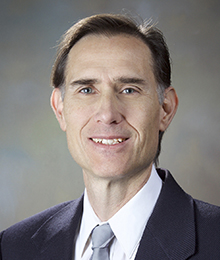AIAA names two Sandians as associate fellows
You might say Sandia aerospace engineer Srinivasan Arunajatesan went into the field because of his sister. Sandia colleague Vicente Romero went into mechanical engineering because of exposure to science and technology in school and through extracurricular activities he pursued while growing up.
Srinivasan, who joined Sandia in 2010, and Vicente, who came to Sandia in 1987, have been named 2018 associate fellows of the American Institute of Aeronautics and Astronautics. The institute says only about 1 percent of its members ever achieve that rank.
“It’s a little bit humbling for me,” Srinivasan says.
Vicente says he was both humbled and grateful. “To be recognized for all the fun and fulfillment I’ve experienced in engineering over the years is like adding frosting to the cake,” he says.
Srinivasan and his sister were accepted into the prestigious Indian Institutes of Technology the same year, and he says he decided he didn’t want to be in the same classes. Since she was studying materials science, “I said I’m doing anything but materials science.” He’d always liked math and physics, so he went into aerospace. It turned out to be a good fit.
“I didn’t grow up looking at the stars; that was not me. I was much more of a math and physics geek,” he says. “Aerospace back then in India was a very small industry, so the people who were there were there because they really liked it. We had the luxury of having some really good teachers and I got hooked on that.”

Srinivasan graduated with a bachelor’s in aerospace engineering and went to work for a company that made trainer aircraft because he wanted to make airplanes. After a year, “I realized it was not as glamorous as I’d thought,” and he wanted to go back to research. He returned to the Indian Institutes of Technology on a research associateship, then went on to graduate school at Georgia Tech, where he received master’s and doctoral degrees in aerospace engineering.
He went to work for a company near Philadelphia, where he remained for more than 11 years. Then a Sandia manager he saw at a conference urged him to consider Sandia. Srinivasan applied and was hired.
The aerospace field keeps Srinivasan’s interest because of its difficult problems. “I can very confidently say that no matter what I do, the class of problems I work on will not be solved in my lifetime,” he says. “So they’re really, really challenging problems.”
They are also multidisciplinary problems, giving him the opportunity to work with people in other fields. “That has really helped me broaden my horizons,” Srinivasan says. “At Sandia, if you can think of something, there’s somebody working on it.”

Engineering offers challenging problems
Vicente comes from a close-knit Santa Fe family he describes as “an eclectic set of restauranteurs, artists, and flamenco musicians and dancers on one side — except for my dad, who was a plumber — and construction workers on the other side.” There were no engineers in sight, but he pursued his interests in science and engineering through school and his own discovery of the natural world, chemistry, and electronics, and working models of cars, airplanes, and rockets.
By the end of his junior year of high school, he had decided on engineering in college. He graduated from New Mexico State University with a bachelor’s degree in mechanical engineering and joined Sandia, where he has worked since in various engineering departments
He received his master’s in mechanical engineering from Stanford University under Sandia’s One Year On Campus program and his doctorate in mechanical engineering from the University of New Mexico through the Labs’ University Part Time program.
Vicente says he enjoys “the practice of thoughtful and creative engineering on challenging problems, and am very appreciative of the opportunities Sandia provides with its large and diverse science and engineering portfolio and its important national mission drivers. I have been fortunate to be able to pursue intellectual exploration coupled with rigorous testing and analysis in a number of areas like computational physics modeling and simulation, systems engineering and algorithms for uncertainty quantification and risk analysis.”
Associate fellows, nominated by other AIAA members, have accomplished or been in charge of important engineering or scientific work, have done original work of outstanding merit, or have otherwise made outstanding contributions to the arts, sciences, or technology of aeronautics or astronautics, according to the institute’s website.